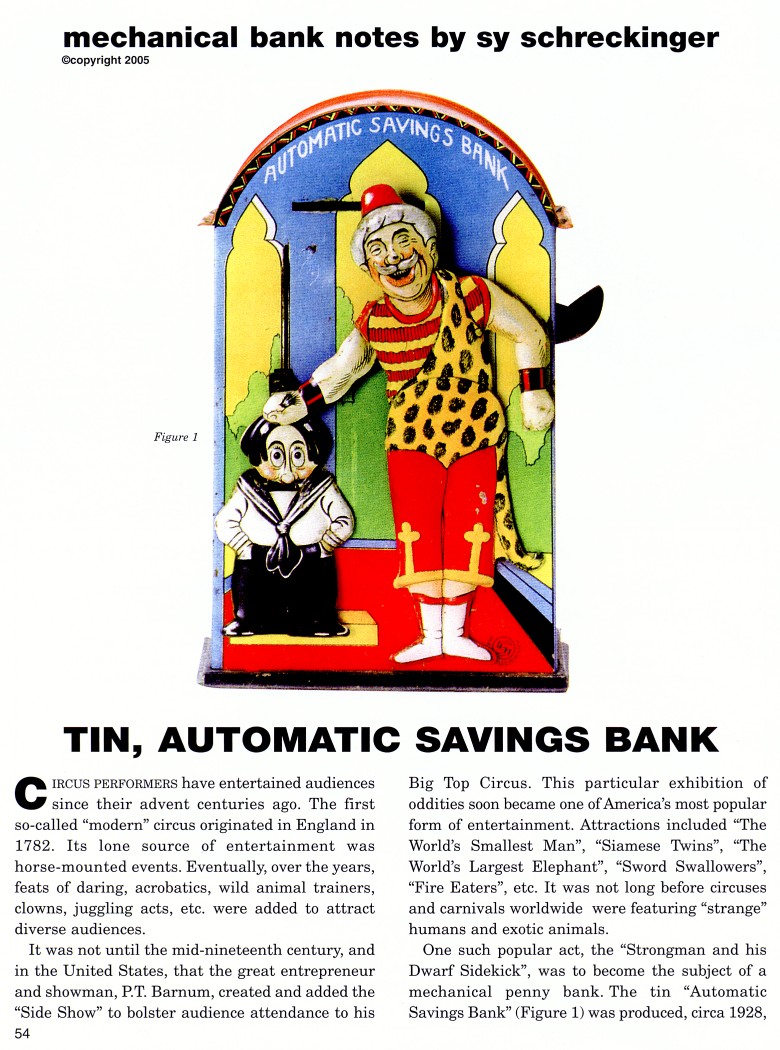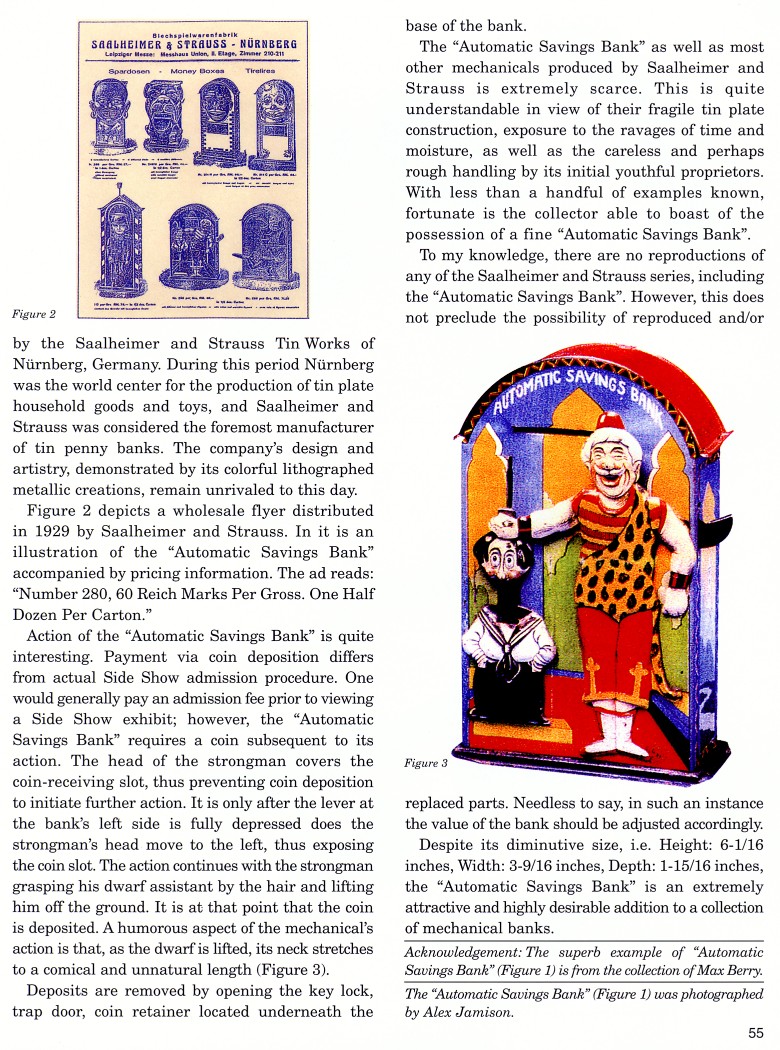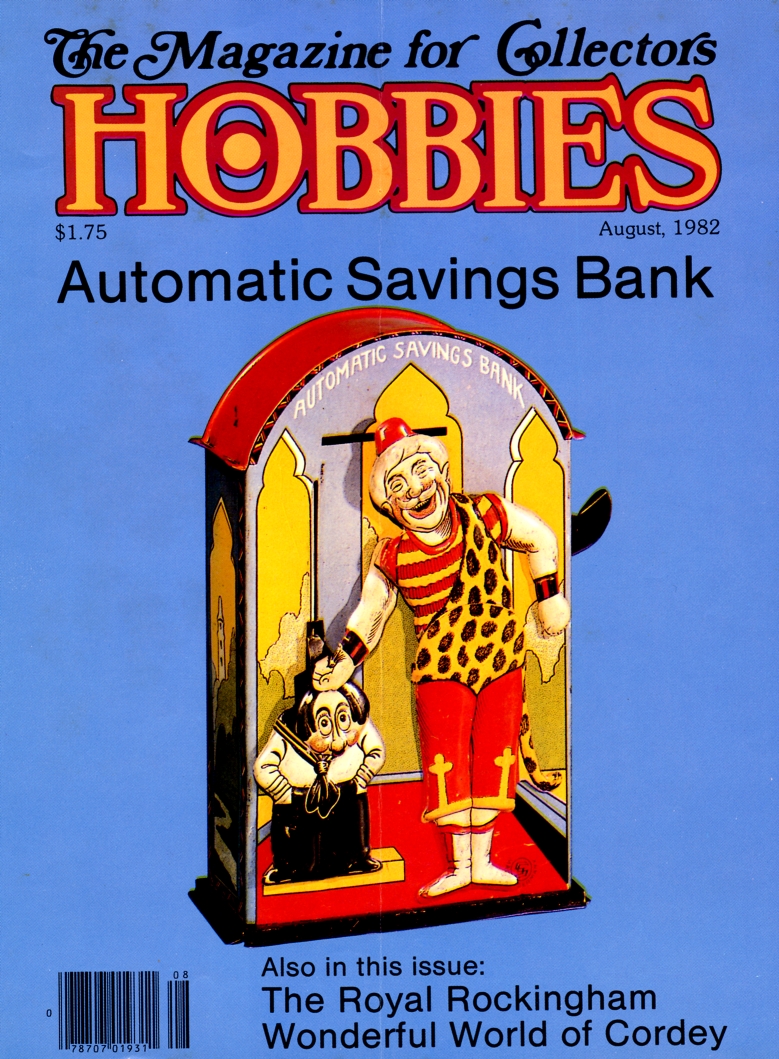|
Tin, Automatic Savings
Bank
by Sy Schreckinger – ANTIQUE TOY WORLD Magazine – June, 2005
Circus performers have entertained audiences since their advent
centuries ago. The first so-called "modern" circus originated in England
in 1782. Its lone source of entertainment was horse-mounted events.
Eventually, over the years, feats of daring, acrobatics, wild animal
trainers, clowns, juggling acts, etc. were added to attract diverse
audiences.
It was not until the mid-nineteenth century, and in the United
States, that the great entrepreneur and showman, P.T. Barnum, created and
added the "Side Show" to bolster audience attendance to his Big Top
Circus. This particular exhibition of oddities soon became one of
America's most popular form of entertainment. Attractions included "The
World's Smallest Man", "Siamese Twins", "The World's Largest Elephant",
"Sword Swallowers", "Fire Eaters", etc. It was not long before circuses
and carnivals worldwide were featuring "strange" humans and exotic
animals.
One such popular act, the "Strongman and his Dwarf Sidekick", was to
become the subject of a mechanical penny bank. The tin "Automatic Savings
Bank" (Figure 1) was produced, circa 1928, by the Saalheimer and Strauss
Tin Works of Nurnberg, Germany. During this period Nurnberg was the world
center for the production of tin plate household goods and toys, and
Saalheimer and Strauss was considered the foremost manufacturer of tin
penny banks. The company's design and artistry, demonstrated by its
colorful lithographed metallic creations, remain unrivaled to this day.
Figure 2 depicts a wholesale flyer distributed in 1929 by Saalheimer
and Strauss. In it is an illustration of the "Automatic Savings Bank"
accompanied by pricing information. The ad reads: "Number 280, 60 Reich
Marks Per Gross. One Half Dozen Per Carton."
Action of the "Automatic Savings Bank" is quite interesting. Payment
via coin deposition differs from actual Side Show admission procedure. One
would generally pay an admission fee prior to viewing a Side Show exhibit;
however, the "Automatic Savings Bank" requires a coin subsequent to its
action. The head of the strongman covers the coin-receiving slot, thus
preventing coin deposition to initiate further action. It is only after
the lever at the bank's left side is fully depressed does the strongman's
head move to the left, thus exposing the coin slot. The action continues
with the strongman grasping his dwarf assistant by the hair and lifting
him off the ground. It is at that point that the coin is deposited. A
humorous aspect of the mechanical's action is that, as the dwarf is
lifted, its neck stretches to a comical and unnatural length (Figure 3).
Deposits are removed by opening the key lock, trap door, coin
retainer located underneath the base of the bank.
The "Automatic Savings Bank" as well as most other mechanicals
produced by Saalheimer and Strauss is extremely scarce. This is quite
understandable in view of their fragile tin plate construction, exposure
to the ravages of time and moisture, as well as the careless and perhaps
rough handling by its initial youthful proprietors. With less than a
handful of examples known, fortunate is the collector able to boast of the
possession of a fine "Automatic Savings Bank".
To my knowledge, there are no reproductions of any of the Saalheimer
and Strauss series, including the "Automatic Savings Bank". However, this
does not preclude the possibility of reproduced and/or replaced parts.
Needless to say, in such an instance the value of the bank should be
adjusted accordingly.
Despite its diminutive size, i.e. Height: 6-1/16 inches, Width:
3-9/16 inches, Depth: 1-15/16 inches, the "Automatic Savings Bank" is an
extremely attractive and highly desirable addition to a collection of
mechanical banks.
Acknowledgement: The superb example of "Automatic Savings Bank"
(Figure 1) is from the collection of Max Berry.
The "Automatic Savings Bank" (Figure 1) was photographed by Alex
Jamison.
|



